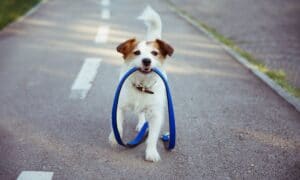“This post contains affiliate links, and I will be compensated if you make a purchase after clicking on my links.”

The three D’s of dog training are essential components to creating a truly obedient and reliable dog. True obedience training is your dog respecting and trusting you, so they will listen to you whenever, wherever, and under whatever circumstances. This means you do not need to bribe them with treats or force them into the commands.
In order to successfully train your dog to a high level of obedience, you need to train them on the three D’s – Duration, Distance, and Distractions.
Duration – Length of time your dog will remain in the command.
Distance – How far you can walk away from your dog without them breaking the command.
Distractions – The dog’s ability to listen and perform the command when presented with various levels of distractions.
In order for me to feel confident that a dog is fully trained (whether it be on leash or off leash trained) I want to make sure the dog will remain in the command for long amounts of time, remain in the desired command while I walk faraway or leave the room, and the dog will perform the command when there is a high level of distractions present.
The key aspect to training the Three D’s (or any other aspect of dog training) is consistency and progressive implementation in order to be successful. We can’t expect our dog to remain in a down while we walk away, three bikes pass, and two dogs run by after only three days of training. It is imperative that we set ourselves and our dog up for success by slowly increasing the duration, distance, and distractions until we have a highly trained and reliable dog.
In my opinion, having a fully trained dog should be every owner’s goal. Having a companion that is obedient and listens all the time not only makes life easier for you the owner, but it enables your dog to be included in more activities and aspects of the family’s life then he would if he was untrained. You can take a fully trained dog to the beach to run around and come back when called, you can take a fully trained dog to your Aunt’s house for Christmas and have him in a place command, you can have your fully trained dog at your son’s soccer game and relax in a down command. However, you can’t have an untrained dog at these events because it will not only be stressful for you and the dog, but also a possible liability. Begin training your dog on the three D’s of dog training today, and we can continue “Changing the World for Dogs”.
This article was written for The Dogington Post by guest author and dedicated dog trainer, Steve Reid. Steve is a Certified Dog Trainer and owner of S.R. Dog Training, LLC based in Westchester, NY. Steve’s mission is on “Changing the World for Dogs”. For more information about S. R. Dog Training, send an e-mail to [email protected], call 914-774-7654 or visit www.srdogtraining.com.
For more training tips, tricks, and advice, become a fan of S.R. Dog Training on Facebook by clicking here.
























George Chase
says:I’m with the Boxer/Chihuahua, the pit has to go.
sharon camel
says:Thank you…I did give her to her original foster/owner.
While I long for her presence, it was very evident my Harvey was affected too negatively. The pit, Maizey, will have a wonderful life. And now Harvey is back to himself in such a short amount of time. He ate as soon as Maizey left and he has remained downstairs ever since. Relaxed and calm.
Thanks again!
sharon camel
says:I am the owner of an almost 3 yr. old Lab, female. An almost 2.5 mix (Boxer, Chihuahua, etc.) male. Last week I rescued a 10 week old Pitt Bull, female. My male dog has been in fear for quite a while. Of other dogs mostly. While he is tolerating the new addition, he is also separating himself from the pack by staying upstairs almost constantly. He did bite at the puppy once over a spaghetti noodle that, unbeknownst to me, was laying on the floor. He did draw blood and the puppy was in considerable pain. He has, over the past year, begun to be aggressive with the Lab ONLY in the yard.
He went through obedience training and was referred to, by the trainer, as the ‘special needs’ dog. Where do I go from here with Harvey?
I need to begin training Maizey, the new puppy. Sadie, the Lab, needs reinforcement training as she jumps on company and simply doesn’t want to listen. I can bribe with treats, but this is not what will create balance within our pack. I need to be the pack leader. I appreciate and thank you in advance for any direction you may have for us.
Sincerely,
Sharon Camel